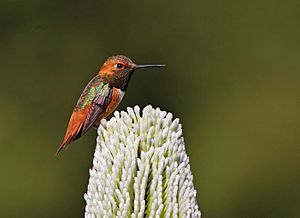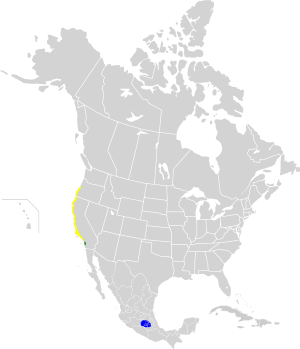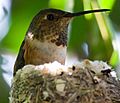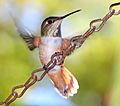Allen's hummingbird facts for kids
Quick facts for kids Allen's hummingbird |
|
|---|---|
 |
|
| Adult male | |
| Conservation status | |
| Scientific classification | |
| Genus: |
Selasphorus
|
| Species: |
sasin
|
 |
|
| Range of S. sasin Breeding range Year-round range Wintering range | |
The Allen's hummingbird (Selasphorus sasin) is a tiny bird that lives in the western United States. It is a type of hummingbird.
These small birds grow to be only about 3 to 3.5 inches (7.6 to 8.9 cm) long. Male Allen's hummingbirds have bright green backs and heads. Their sides, bottom, and tail feathers are a rusty orange color. Their throats glow with a shiny orange-red color.
Female Allen's hummingbirds and young ones look similar to the males. But they do not have the glowing throat patch. Instead, they have small spots on their throats. Females are mostly green, with some rusty color and white tips on their tails. Young Allen's hummingbirds look very much like female rufous hummingbirds. It can be hard to tell them apart in nature. Scientists often look at where and when they breed to tell the two species apart.
What's in a Name?
The Allen's hummingbird was first officially described in 1829. A French scientist named René Lesson gave it the scientific name Ornismya sasin. The name "sasin" comes from a Native American word for hummingbird.
Later, the bird was placed in the genus Selasphorus. The common name "Allen's hummingbird" honors Charles Andrew Allen. He was an American collector who found the bird in 1879 in California.
There are two main types, or subspecies, of Allen's hummingbird:
- S. s. sasin: This type breeds in southern Oregon and California. It spends winters in south-central Mexico.
- S. s. sedentarius: This type lives all year on islands off southern California. It has also spread to parts of Los Angeles and Orange Counties.
Sometimes, Allen's hummingbirds can breed with Anna's hummingbirds. Their mixed offspring are called Floresi's hummingbird.
Where Do They Live?
Allen's hummingbirds are often found in brushy woods, gardens, and meadows. They live along the coast of California, from Santa Barbara north. They also live in southern coastal Oregon.
One type, S. s. sasin, travels long distances. It flies south to central Mexico for the winter. The other type, S. s. sedentarius, stays in California all year. This group has moved from the Channel Islands to the mainland. They now live in many parts of Los Angeles and Orange Counties. They have also spread south to San Diego County and east to Riverside County.
How They Behave
Male Allen's hummingbirds do a special dance to attract females. They fly back and forth like a swinging pendulum, about 25 feet (7.6 m) wide. Then, they dive from about 100 feet (30 m) high. As they dive, their tail feathers make a sharp fluttering sound. This sound helps get the female's attention.
These hummingbirds are very protective of their space. Male Allen's hummingbirds will chase away other males from their area. They will also chase away other types of hummingbirds. They have even been seen attacking much larger birds, like kestrels and hawks!
Allen's hummingbirds build their nests from plant fibers and soft plant down. They use lichens and spider webs to make the nest strong. The nest is usually placed on a tree branch or a plant stem. The female lays one or two white eggs. She sits on them for about 15 to 17 days until they hatch.
The baby birds leave the nest about three weeks after hatching. Their mother keeps feeding them for several more weeks. After that, the young birds learn to find food on their own.
Like all hummingbirds, Allen's hummingbirds need to eat often. This is because they have a very fast metabolism. They drink sweet nectar from flowers. They also eat small insects they catch in the air or on flowers. These insects give them the protein they need.
Gallery
- BirdLife species factsheet for Selasphorus sasin
- Lua error in Module:EditAtWikidata at line 29: attempt to index field 'wikibase' (a nil value).
- Interactive range map of Selasphorus sasin at IUCN Red List maps
- Audio recordings of Allen's hummingbird on Xeno-canto.
See also
 In Spanish: Colibrí de Allen para niños
In Spanish: Colibrí de Allen para niños







